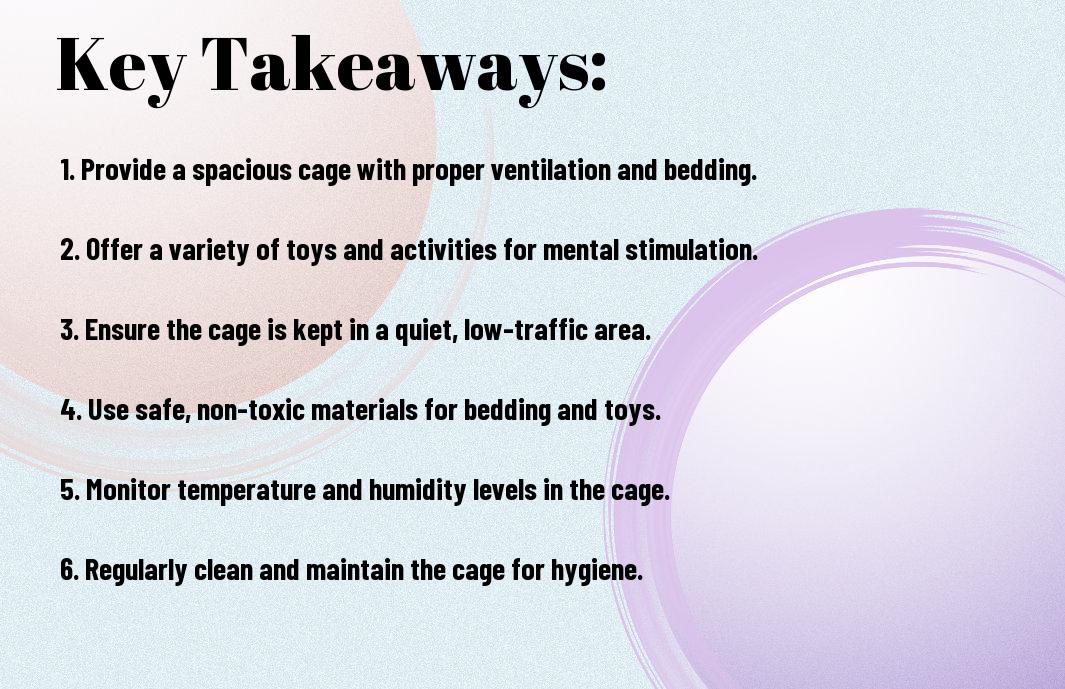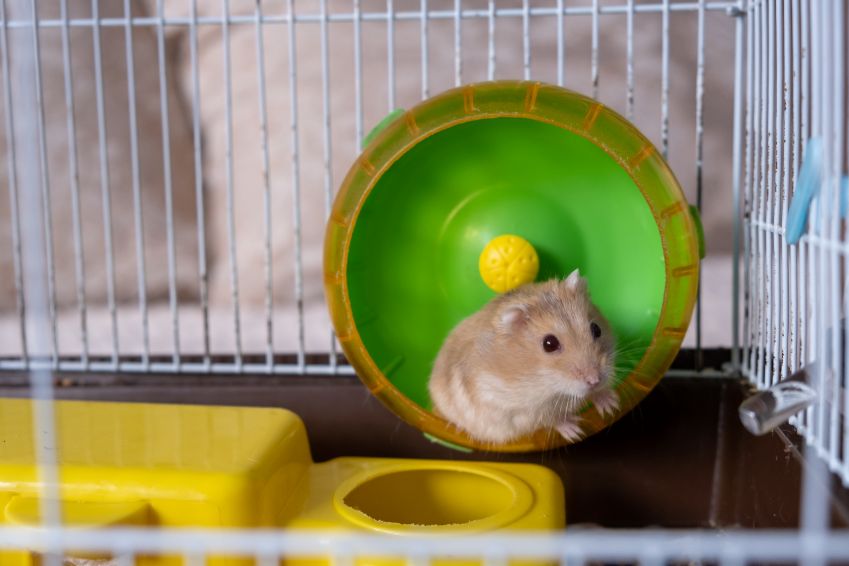Ensuring the safety and stimulation of your hamster’s living environment is crucial for their health and well-being. Providing proper housing, enrichment activities, and regular maintenance are key factors in creating a space where your hamster can thrive. In this blog post, we will discuss the essential steps you can take to create a safe and stimulating environment for your beloved pet.
Key Takeaways:
- Provide a suitable habitat: Ensure that your hamster has a spacious cage with appropriate bedding, hiding spots, and toys to keep them mentally stimulated.
- Monitor and maintain temperature and humidity: Keep the environment at a comfortable temperature and humidity level to prevent any potential health issues for your hamster.
- Keep the cage clean and secure: Regularly clean the cage to prevent the buildup of bacteria and provide a secure environment to keep your hamster safe from potential hazards.

Creating a Safe Hamster Environment
While it may seem like a small and simple task to create a safe environment for your hamster, it is crucial to ensure that their habitat is free from any potential hazards. By taking the time to set up a safe and stimulating environment for your hamster, you can help to ensure their overall well-being and happiness.
Choosing the Right Cage
When selecting a cage for your hamster, it is essential to choose one that provides enough space for them to move around comfortably. Make sure that the cage has a solid bottom to prevent any potential injuries, and that the bars are spaced close enough together to prevent your hamster from escaping. Additionally, you should avoid cages with wire floors, as they can cause pain and injury to your hamster’s feet.
Safe Bedding and Materials
When it comes to bedding and materials for your hamster’s habitat, it is important to choose options that are safe and non-toxic. Opt for bedding made from paper-based materials or aspen shavings, and avoid cedar or pine shavings which can release harmful fumes. Additionally, you should provide your hamster with safe materials for nesting and burrowing, such as untreated wood, hay, or shredded paper.
Temperature Control and Lighting
Ensuring the right temperature and lighting in your hamster’s habitat is essential for their well-being. Hamsters are sensitive to high temperatures, so it is important to keep their environment between 65-75 degrees Fahrenheit. Additionally, you should provide a consistent light-dark cycle for your hamster, mimicking their natural environment. This can be achieved by placing their habitat in a room with natural light, or using a low-wattage bulb on a timer.
Chapter: Essentials of Hamster Stimulation
After setting up a safe and secure environment for your hamster, the next step is to ensure they have plenty of stimulation to keep them happy and healthy. Hamsters are curious, active animals that need mental and physical stimulation to thrive. Providing the right environment and toys for your hamster is essential for their well-being.
Exercise Wheels and Tunnels
One of the most important stimulation essentials for your hamster is an exercise wheel. Hamsters are natural runners and need the opportunity to exercise to stay healthy and happy. Make sure the wheel is properly sized for your hamster to avoid any injuries from a too small or too big wheel. Adding tunnels to their habitat can also provide mental and physical stimulation, giving them a place to explore and play.
Toys and Chewing Accessories
In addition to an exercise wheel and tunnels, it’s important to provide your hamster with a variety of toys and chewing accessories. Hamsters need to gnaw to keep their teeth healthy and preventing overgrowth. Providing safe chew toys and accessories can help fulfill this need. Look for toys made of safe, non-toxic materials and provide a variety of textures and shapes to keep your hamster engaged and entertained.
The Need for Exploration and Playtime
Your hamster also needs the opportunity for exploration and playtime outside of their cage. Use a secure playpen or a hamster ball to give them a chance to explore new surroundings under your supervision. This will keep your hamster mentally stimulated and give them a break from the confines of their cage. Always remember to supervise playtime and ensure that the playing area is completely safe and escape-proof.
By providing exercise wheels, tunnels, toys, and opportunities for exploration and playtime, you can create a stimulating environment for your hamster that will keep them happy and healthy. Remember to always prioritize their safety and well-being when choosing toys and accessories for your furry friend. Regularly inspect and clean toys and accessories to ensure they remain safe and enjoyable for your hamster.
Ongoing Care and Safety Checks
Your hamster’s safety and well-being rely heavily on the ongoing care and safety checks you perform. Being consistent in your efforts to maintain a safe and stimulating environment is crucial for your hamster’s health and happiness.
Routine Cage Maintenance
Regular cage maintenance is essential for creating a safe and stimulating environment for your hamster. You should clean the cage at least once a week, removing soiled bedding, food, and any waste your hamster has accumulated. It’s important to thoroughly clean and disinfect the cage to prevent the buildup of harmful bacteria and odors. In addition to regular cleaning, ensure that the cage is secure and free from any potential hazards, such as sharp edges or loose wires that may harm your hamster.
Monitoring Your Hamster’s Health and Behavior
Keep a close eye on your hamster’s health and behavior to ensure they are in good spirits. Regularly check for any signs of illness or distress such as changes in appetite, abnormal vocalizations, or lethargy. Additionally, observe your hamster’s activity level and behavior to ensure they are displaying normal and healthy habits. If you notice any concerning changes, it’s important to seek veterinary care promptly to address any potential health issues.
Advanced Tips and Tricks
Lastly, let’s delve into some advanced tips and tricks to create an even more stimulating environment for your hamster. Here are some ideas to take your hamster’s habitat to the next level:
- DIY Enrichment Ideas
- Interaction and Taming for Mental Stimulation
DIY Enrichment Ideas
For DIY enrichment, you can create tunnels and mazes using cardboard tubes, boxes, and other safe materials. Hide treats inside these tunnels to encourage your hamster to forage and keep them mentally engaged. You can also create a digging box with child-safe, pesticide-free soil for your hamster to mimic their natural behavior of burrowing. Simply place the digging box in their habitat and watch them have fun for hours.
Interaction and Taming for Mental Stimulation
Interacting with your hamster through handling and taming can greatly contribute to their mental stimulation. Spend time each day gently handling your hamster, allowing them to get used to your touch and presence. Use positive reinforcement techniques such as offering treats to create a bond of trust between you and your pet. This interaction will not only stimulate them mentally but will also strengthen the bond between you and your hamster.
Creating a Safe and Stimulating Environment for Your Hamster
From above all, it is crucial to provide a safe and stimulating environment for your hamster by ensuring their cage is secure, free from hazardous materials, and contain plenty of toys and exercise opportunities. Keep in mind that hamsters are curious and active animals, so providing a varied and interesting environment is essential for their wellbeing. By following these guidelines, you can ensure that your hamster is happy and healthy in their living space. Remember, it is your responsibility to create a safe and stimulating environment for your small furry friend.
FAQ
Q: What type of cage is best for creating a safe environment for my hamster?
A: The best type of cage for a hamster is a wire or plastic enclosure with a solid bottom to prevent injury. Make sure the spacing between bars is narrow enough to prevent escape. Provide ample space for your hamster to roam and explore, with multiple levels and tunnels for stimulation.
Q: What bedding should I use to create a comfortable and safe environment for my hamster?
A: Use a soft, dust-free bedding material such as aspen or paper-based bedding to create a comfortable and safe environment for your hamster. Avoid cedar or pine bedding as these can be harmful to your hamster’s respiratory system.
Q: How can I provide a stimulating environment for my hamster in its cage?
A: To create a stimulating environment for your hamster, provide a variety of chew toys, hiding spots, and a exercise wheel. You can also add tunnels, branches, and cardboard tubes for your hamster to explore. Rotate and change the toys and objects in the cage regularly to keep your hamster engaged and entertained.














